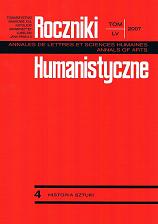Historia kurtyny teatralnej
The History of the Theatrical Curtain
Author(s): Agnieszka KuczyńskaSubject(s): Cultural history
Published by: Towarzystwo Naukowe KUL & Katolicki Uniwersytet Lubelski Jana Pawła II
Keywords: theatrical curtain; ancient times; Middle Ages; modernity; modern art; decoration; work of art; kurtyna teatralna; starożytność; średniowiecze; nowożytność; sztuka nowoczesna; dekoracja; dzieło sztuki
Summary/Abstract: This paper outlines the history of the theatrical curtain that reaches back to ancient times. It also attempts to define its function and formulate a definition of this genre of art. In the Roman theatre there were two kinds of curtains: one that separated a part (Lat. siparium) or the whole of the stage from the audience (the so-called auleum). The historical evolution of the basic function of the curtain tended to enrich and elevate its meaning. The curtain should be regarded as an integral element of the theatrical interior, an individualised element and relatively autonomic. It was ornamented with woven, embroidered or painted representations. It also played a symbolic role, i.e. “the border of two worlds”: reality (on the part of the viewer) and illusive fiction (on the part of the theatrical action). The nineteenth and twentieth centuries saw some changes in the way to understand the “theatrical character”. As a result of them, the role of the curtain also changed. It became a part of the conception of stage design for a concrete performance. Eventually, the avant-garde of the twentieth century postulate to make the theatre “come closer to life”, therefore it questioned the division of the two “worlds” in general, and eliminated the curtain.
Journal: Roczniki Humanistyczne
- Issue Year: 55/2007
- Issue No: 04
- Page Range: 121-150
- Page Count: 30
- Language: Polish

